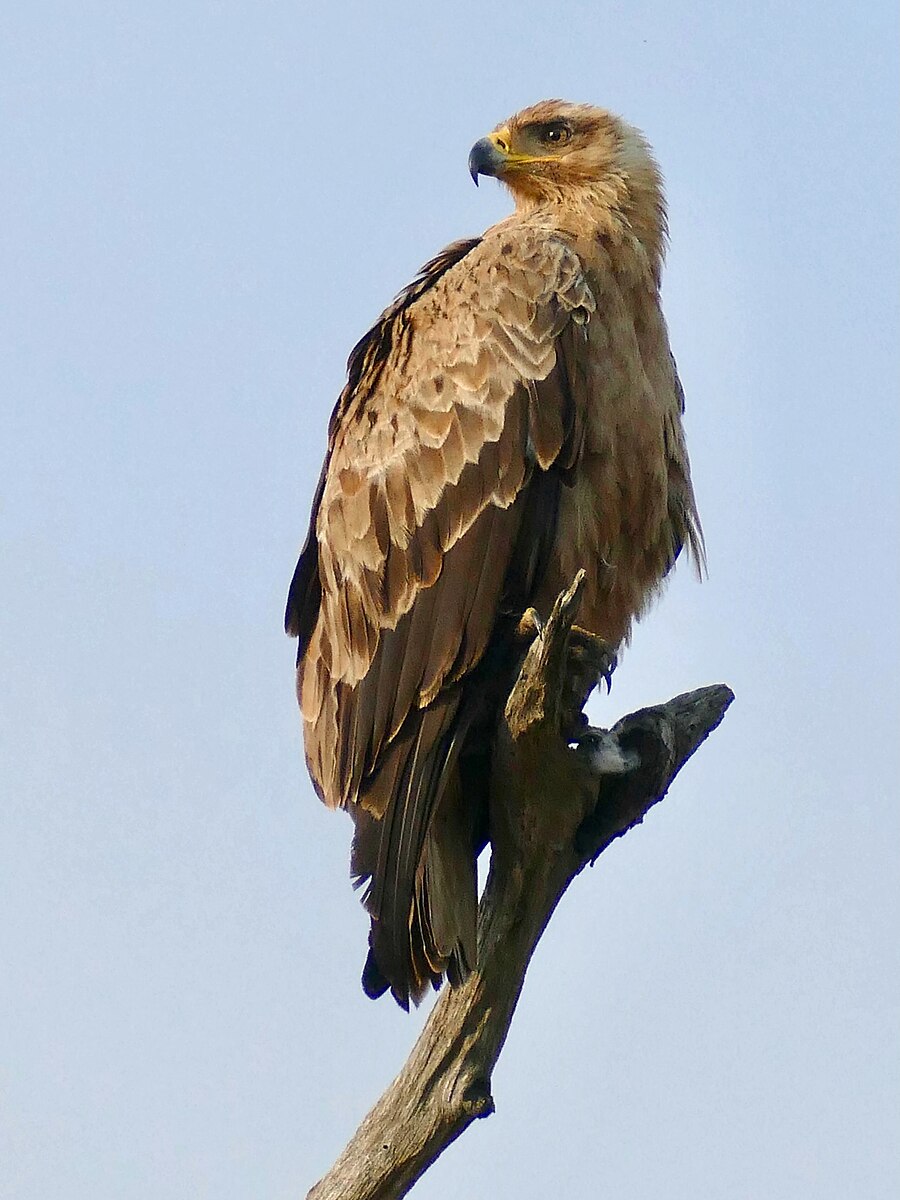For animal enthusiasts with advanced knowledge, the comparison between a tawny eagle and an owl involves a detailed analysis of various aspects, including physical attributes, hunting techniques, and habitats. This article provides a thorough examination of these two bird species, focusing on their unique features and abilities.
Physical Attributes and Size
Tawny eagles (Aquila rapax) are large birds of prey, with a body length ranging from 56 to 75 cm (22 to 30 in) and a wingspan of 131-188 cm (4 ft 4 in – 6 ft 2 in). They have a robust body, with broad wings and a short, square-cut tail. Their plumage is mostly brown, with darker feathers on the wings and back, and a pale, creamy-buff color on the belly and chest. The head is marked with a distinctive dark patch around the eyes, giving them a fierce appearance.
Owls, on the other hand, exhibit a wide range of sizes and appearances, depending on the species. For the purpose of this comparison, we will focus on two common owl species: the barn owl (Tyto alba) and the tawny owl (Strix aluco).
Barn owls are medium-sized owls, with a body length of 33-39 cm (13-15 in) and a wingspan of 80-95 cm (31-37 in). They have a distinctive heart-shaped face, long, slender wings, and a short, squarish tail. Their plumage is mostly white or light grey, with darker markings on the wings and back.
Tawny owls are slightly larger, with a body length of 37-43 cm (14.5-17 in) and a wingspan of 96-110 cm (37.8-43.3 in). They have a rounded head with no ear tufts, and their plumage is a mottled brown, sometimes with a greyish or reddish tint.
Hunting Techniques and Prey
 Image source: Tawny Eagle by Bernard DUPONT
Image source: Tawny Eagle by Bernard DUPONT
Tawny eagles are powerful hunters, primarily targeting birds, reptiles, and small mammals. They have excellent vision, allowing them to spot prey from great heights. They hunt by soaring high in the sky, then diving at high speed to snatch their prey from the ground or from trees.
Owls, with their exceptional night vision and silent flight, are expert nocturnal hunters. Barn owls, in particular, are highly skilled at hunting in total darkness, using their acute hearing to locate prey. They primarily feed on small mammals, such as rodents and voles, but will also take birds, amphibians, and insects.
Tawny owls are also nocturnal hunters, relying on their excellent camouflage to ambush prey. They feed on a variety of small mammals, birds, and invertebrates.
Habitats and Distribution
Tawny eagles are found throughout Africa, southern Europe, the Middle East, and central Asia. They prefer open habitats, such as grasslands, savannas, and deserts, but can also be found in more wooded areas.
Barn owls have a global distribution, found on every continent except Antarctica. They prefer open habitats, such as farmlands, grasslands, and marshes, but can also be found in wooded areas and urban environments.
Tawny owls are native to Europe, Asia, and North Africa, with a range extending from the British Isles to Japan. They prefer wooded habitats, but can also be found in parks and gardens in urban areas.
Advanced Details and Specifications
Tawny eagles have a unique hunting technique called “wing-clapping,” where they rapidly beat their wings while hovering in place, creating a loud noise to scare prey into moving. They have powerful talons, which they use to kill their prey by crushing the skull or breaking the spine.
Barn owls have a highly modified skeletal structure, allowing them to turn their heads up to 270 degrees, giving them a wide field of vision. They also have specialized feathers on their wings, which allow them to fly silently, making it easier to sneak up on prey.
Tawny owls have large, forward-facing eyes, providing them with binocular vision and depth perception. They also have a keen sense of hearing, which they use to locate prey in complete darkness.
Real-life Incidents and Statistics
Tawny eagles are known to attack and kill larger prey, such as flamingos and young gazelles, when the opportunity arises. They have also been observed stealing prey from other birds of prey.
Barn owls are estimated to consume around 1,000 rodents per year, making them valuable allies in controlling pest populations.
Tawny owls are known for their aggressive defense of their nests, attacking intruders, including humans, if they feel threatened.
References:
– Robert E Fuller, Barn Owl vs Tawny Owl | Bonnie & Ozzy | Robert E Fuller – YouTube, Dec 15, 2022, https://www.youtube.com/watch?v=8FLJiCpJcms
– Wildlife Watch, How to identify owls | Wildlife Watch, https://www.wildlifewatch.org.uk/wildlife-zone/identify-wildlife/how-identify-owls
– The Wildlife Trusts, How to identify owls | The Wildlife Trusts, https://www.wildlifetrusts.org/wildlife/how-identify/how-identify-owls
– Golden Eagle vs Eurasian Eagle Owl – Who would win? – YouTube, Mar 8, 2022, https://www.youtube.com/watch?v=I7qz3qNrM6s
– Wikipedia, Eurasian eagle-owl – Wikipedia, https://en.wikipedia.org/wiki/Eurasian_eagle-owl

